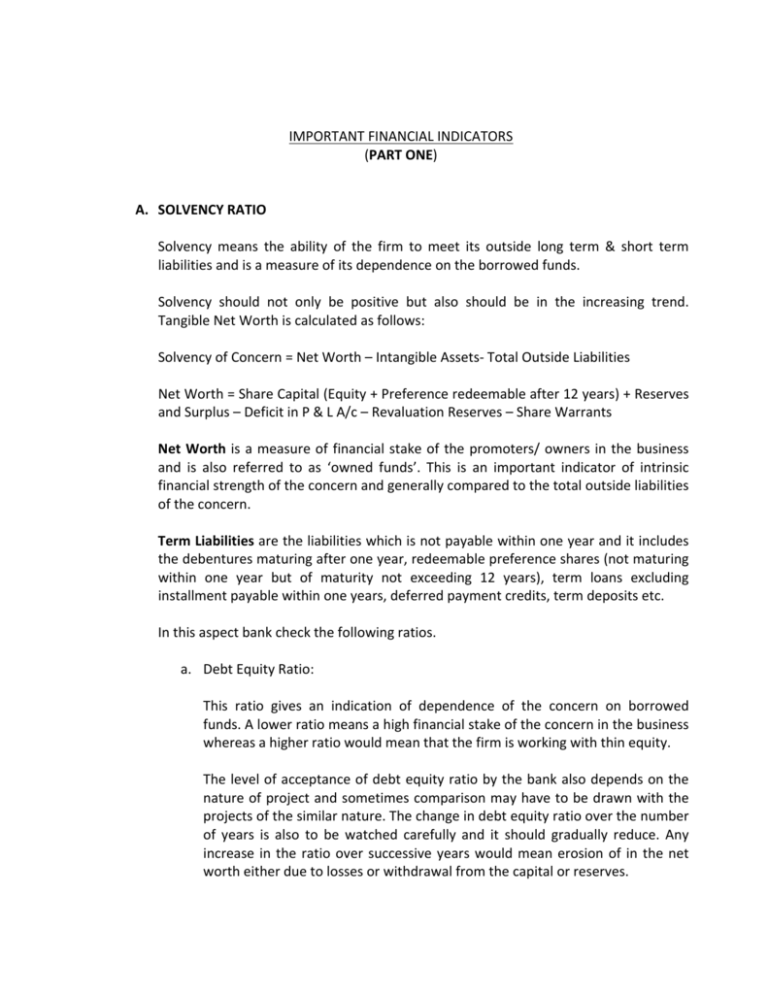important financial indicators
advertisement

IMPORTANT FINANCIAL INDICATORS (PART ONE) A. SOLVENCY RATIO Solvency means the ability of the firm to meet its outside long term & short term liabilities and is a measure of its dependence on the borrowed funds. Solvency should not only be positive but also should be in the increasing trend. Tangible Net Worth is calculated as follows: Solvency of Concern = Net Worth – Intangible Assets‐ Total Outside Liabilities Net Worth = Share Capital (Equity + Preference redeemable after 12 years) + Reserves and Surplus – Deficit in P & L A/c – Revaluation Reserves – Share Warrants Net Worth is a measure of financial stake of the promoters/ owners in the business and is also referred to as ‘owned funds’. This is an important indicator of intrinsic financial strength of the concern and generally compared to the total outside liabilities of the concern. Term Liabilities are the liabilities which is not payable within one year and it includes the debentures maturing after one year, redeemable preference shares (not maturing within one year but of maturity not exceeding 12 years), term loans excluding installment payable within one years, deferred payment credits, term deposits etc. In this aspect bank check the following ratios. a. Debt Equity Ratio: This ratio gives an indication of dependence of the concern on borrowed funds. A lower ratio means a high financial stake of the concern in the business whereas a higher ratio would mean that the firm is working with thin equity. The level of acceptance of debt equity ratio by the bank also depends on the nature of project and sometimes comparison may have to be drawn with the projects of the similar nature. The change in debt equity ratio over the number of years is also to be watched carefully and it should gradually reduce. Any increase in the ratio over successive years would mean erosion of in the net worth either due to losses or withdrawal from the capital or reserves. Debt Equity Ratio = Total Term Liabilities/ Tangible Net Worth Debt Equity ratio of 2: 1 is generally acceptable b. Total Indebtedness Ratio This ratio takes into consideration the total term liabilities as well as current liabilities into consideration and hence better indicator of solvency of the concern. Higher ratio would indicate excessive dependence on outside funds and may be considered as a negative factor. Total Indebtedness Ratio = Total Outside Liabilities/ Tangible Net Worth B. LIQUIDITY RATIOS Current Liabilities: All liabilities which are short term in nature and payable within a period of one year is considering a current liability. It includes the Sundry trade creditors, intt. & other charges accrued but not due for payments, short term borrowings (including bills purchased & discounted), advance payments from customers, installments of term loan including deferred payments credits, debentures etc payable during the period of one year. The provisions made for expenses and taxes (net off advance tax) are also taken as current liabilities. It excludes the disputed liability under sales tax and excise duty which has not been actually collected by the concern. Current Assets: It includes the cash & bank balance, investments in government & other trustee’s securities including FDR with banks, receivables arising out of sales including exports, inventories/stocks, installments deferred receivables due within one year, prepaid expenses etc. It excludes the investments in shares & advances to other firm/companies, not connected with the business of the concern; Investments for long term purpose e.g. sinking fund, gratuity funds etc., FDR with banks as margin against non‐fund based credit facilities, receivables outstanding more than six months etc. a. Current Ratio Current ratio is a comparison of current assets in relation to current liabilities and is calculated as under: Current Ratio = Current Assets/ Current Liabilities As per Reserve Bank of India’s guidelines a minimum current ratio of 1.33: 1 is to be ensured by the banks. The other important aspect is to examine the movement of current ratio over a period of time. An increasing trend is an indicator of improving position of a concern while a decrease in the ratio may have doubt in the overall functioning of the concern. A deteriorating CR will either means successive losses or diversion of short term funds for long term usage which are negative factor and may influence the decision of the banks. In case of take over of working capital loan from present bank of the client the bank look into the last three years CR which should not be less than 1.33 in all these years and should show the increasing trend otherwise the bank may reject the request. In few cases the concerned officer in the bank may seek the special approval from its higher authorities if there is proper justification for lesser ratio. b. Quick or Acid Test Ratio: While calculating current ratio, generally we presume that all current assets will be realized to meet out the current liabilities but some current assets such as prepaid expenses; inventories etc are not readily realizable and hence are not available to meet the current dues of the firm. Hence, to find out the real liquidity of the concern it is important to compare the liquid current assets to current liabilities and determine as under: Quick Ratio = Current Assets – Inventory – Prepaid Expenses Current Liabilities No fixed norms have been prescribed for this ratio but a ratio of 1:1 should be considered as adequate. For any queries, kindly contact: CA. Manoj Kumar Gupta Contact No.: 9350760606 Email‐id: mgupta2803@gmail.com, ca.peregrine@gmail.com






